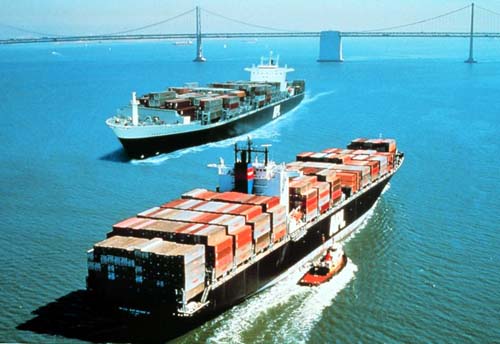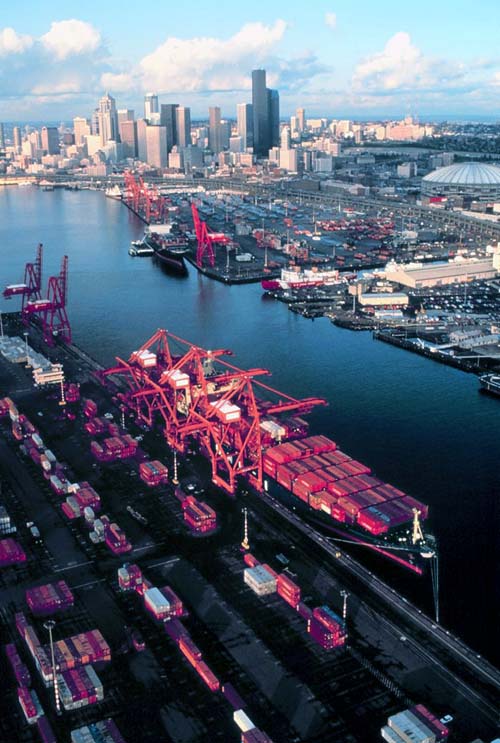The Box
by Andrew Boyd
Today, guest scientist Andrew Boyd discusses The Box. The University of Houston presents this series about the machines that make our civilization run, and the people whose ingenuity created them.
When the converted oil tanker Ideal-X arrived in the Port of Houston on May 1, 1956, no one imagined the global change it foreshadowed. Longshoremen stopped work and ran to the edge of the dock to watch. So did businessmen who had flown from the port of origin in Newark, New Jersey. One witness said, "We had seen thousands of tankers in Houston, but never one like this. So everybody looked at this monstrosity and they couldn't believe their eyes." But it wasn't the ship itself that captured the onlookers' attention. It was the many metal boxes strapped to the deck, each roughly the size of a truck trailer.
In his book The Box, Marc Levinson tells the history of those unpretentious crates. "What is it about the container that is so im-portant?" writes Levinson, "Surely not the thing itself. A soulless aluminum or steel box held together with welds and rivets, with a wooden floor and two enormous doors on one end: the standard container has all the romance of a tin can." In fact, engineers find much to admire. From the design of the corner-posts to the stacking brackets, shipping containers display the finest elements of "here's-a-problem-let's-solve-it" engineering.
But the true marvel of the shipping container was how it changed the engineering of the world economy. Before 1956, packages were loaded by hand. As a result, ships spent weeks in port -- far more time than they spent at sea. Today, huge cranes unload a standard shipping container and return to retrieve another in under two minutes, allowing huge vessels to dock and sail in less than a day. When the Ideal-X first sailed, the cost of loading loose cargo was six dollars a ton. That plummeted to a mere 16 cents with the use of shipping containers.
Great as these savings were, we didn't feel the full impact of container shipping until it spread throughout the supply chain. Trucks and trains were quick to adopt standardized containers. Even manufacturers embraced shipping practices that capitalized on the economies of working "within the box." Industrial engineers and operations researchers stepped up with insightful new mathematics to take full advantage of the efficiencies created by containerization. In less than 50 years -- practically overnight for such a capital-intensive enterprise -- transportation and manufacturing were completely re-engineered.
Great ports that failed to see the coming change disappeared, while others grew to international prominence. Singapore, one of the world's smallest countries and the world's largest container-port, hosted 148 cargo ships per day in 2005, moving the equivalent of 23 million, 20-foot containers during the year. With thousands upon thousands of containers in port at any given time, a drive along the waterfront is a spectacle as impressive as a shuttle launch.
Shipping containers are now part of our daily lives. We pass them on highways -- count them as they go by at train crossings. They're the bits and bytes of an international trade network they created. And the true genius they represent is less the box itself than it is the genius of catching an idea whose time has come.
I'm Andy Boyd, at the University of Houston, where we're interested in the way inventive minds work.
Dr. Andrew Boyd is Chief Scientist and Senior Vice President at PROS, a provider of provider of pricing and revenue optimization solutions. Dr. Boyd received his A.B. with Honors at Oberlin College with majors in Mathematics and Economics in 1981, and his Ph.D. in Operations Research from MIT in 1987. Prior to joining PROS, he enjoyed a successful ten year career as a university professor.
M. Levinson, The Box: How the Shipping Container Made the World Smaller and the World Economy Bigger. (Princeton: Princeton University Press, Princeton, New Jersey, 2006).
Statistics on the Port of Singapore can be found at
https://en.wikipedia.org/wiki/Port_of_Singapore
The two images below -- containers under way on ships and being loaded -- are courtesy of NOAA.

